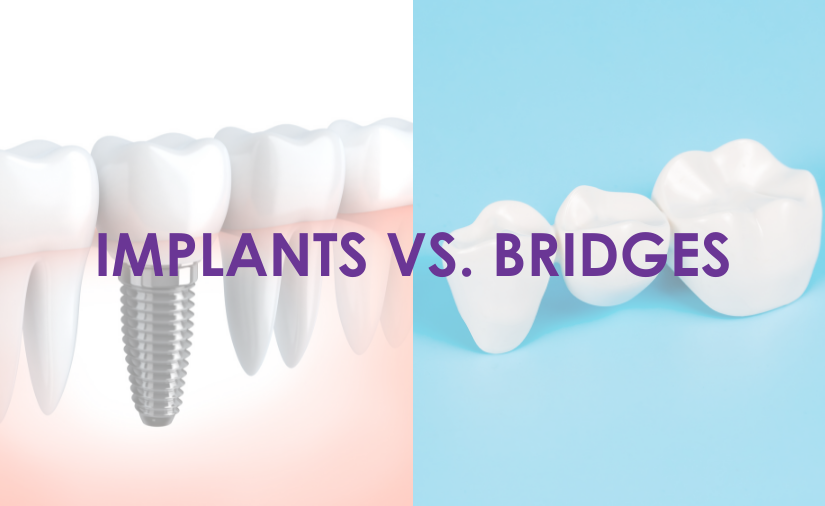By: Dr. Elizabeth Eggert
Losing a tooth can happen to anyone. We see patients who have lost teeth for a variety of reasons, from sports injuries to gum disease from neglecting dental hygiene or from dental decay, the most common reason for tooth loss.
While it’s our top goal as your dental providers to help you keep your teeth and avert tooth loss, some teeth can’t be saved and extraction ends up being the only option. Once a tooth is extracted, each patient faces a choice of how to restore that tooth (or teeth).
There are two main fixed strategies to choose from: implants and bridges. Dr. Elizabeth and Dr. Jeff are committed to helping you understand your options thoroughly so we can help you make an informed choice. We want you to choose a restoration that meets your needs and priorities, so we’ll talk you through all your options in detail.
Here’s some useful information for anyone who is comparing the pros and cons of implants and bridges. Please reach out with any questions about how each of these restoration options will serve you.
Cost
When it comes to cost, bridges are the short-term winner. It costs slightly less to get a bridge than a comparable implant restoration. However, we also urge you to take the long view. Implants are usually “one and done” – they more often last longer. On the other hand, bridges most often have to be replaced at least once in a lifetime, maybe more often.
Speed
Bridges will be completed faster than implants. Because implants require up to six months for the bone to grow around the implant and anchor it properly, implants may require more dental visits. If minimizing your time in our chair is your top priority, you might prefer a bridge over an implant.
Initial Discomfort
An implant is a more invasive procedure, since it requires surgery to get the process started. While local anesthesia means that you won’t feel pain or discomfort during the surgery, there is a short recovery period which will include some discomfort. Usually over-the-counter pain medications are adequate during recovery, and you’ll need to eat soft foods for a day or two. Bridges only require changes to the teeth and do not require oral surgery intervention.
Function
Once your implant is complete, you’ll notice it is much like a healthy tooth of your own. You clean and care for an implant much like you would your real teeth. It can’t get cavities or tooth decay. Caring for a bridge is more complicated because the food traps underneath.
Long-Term Success
A bridge typically is supported by the two teeth adjacent of the missing tooth. This requires that those teeth be modified to accommodate the bridge, which adds extra pressure on them. This is one way that a bridge can fail, by weakening the anchor teeth. Another factor is that implants stimulate the growth of your jaw bone, maintaining a strong and solid foundation for both teeth and implants. Bridges don’t put direct pressure on your jaw bone, so they don’t stimulate that growth. This means that bone loss in the jaw may ultimately jeopardize the anchor teeth, and it may contribute to a somewhat sunken appearance of your lower cheeks.
The right choice for each patient depends on so many factors. We’re excited to have this conversation with all of our patients who have experienced tooth loss.
If you’re facing this important decision, please come and see Dr. Elizabeth and Dr. Jeff. We’ll be happy to generate a treatment plan covering both options and help you make a decision that will keep you and your mouth happy for years to come. Call us today at 651.482.8412 to get on our calendar.

